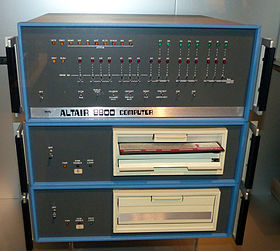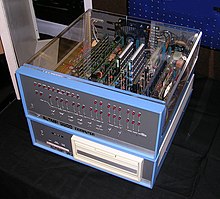Altair 8800
| Altair 8800 | |
|---|---|

|
|
| Manufacturer | MITS |
| Type | Home computer , kit |
| publication | 1975 |
| End of production | 1977 |
| Factory price | at launch:
|
| processor | Intel 8080 |
| random access memory | 256 bytes
|
| graphic | |
| Sound | |
| Disk | Ticker Tape , Compact Cassette , floppy disk |
| operating system | Altair BASIC , CP / M-80 |
| successor | Altair 8800a, Altair 8800b |
The Altair 8800 was an early home computer , then called a " microcomputer " to differentiate it from the refrigerator-sized " minicomputers ". With its toggle switches for input and light-emitting diodes for output ( machine console), this device did not yet have the ease of use of later personal computers , but it was called this by the manufacturer when it was launched. After starting from the machine console, the operating system, programming environments - the Altair BASIC was the first Microsoft software to be sold - or other programs can be loaded from external data storage devices; Input and output can then take place via a connected terminal . The Altair 8800 served as the centerpiece for further developments within the Homebrew Computer Club and thus had a significant influence on the development of the first personal computers .
The computer was developed in 1974 by Ed Roberts and his company Micro Instrumentation and Telemetry Systems ( MITS ) and launched in 1975 for 395 US dollars as a kit using advertisements in popular electronics , radio electronics and other hobbyist magazines. The finished device cost $ 495, based on today's purchasing power around $ 2,400.
history
While serving in the United States Air Force weapons labs in Kirtland, New Mexico , Ed Roberts and Forrest M. Mims III decided to use their electronic background to produce small rocket model kits for hobbyists. To this end, together with Stab Nagle and Robert Zeller, they founded the company Micro Instrumentation and Telemetry Systems , or MITS for short , in Robert's garage in Albuquerque and began to sell radio transmitters and instruments for rocket models.
In 1969, Roberts bought the others' shares and rented a larger office where he made calculator kits. Mims helped him by writing manuals for some of the kits in exchange for kits. In 1972, however, Texas Instruments developed its own chip for pocket calculators and began selling complete pocket calculators for just over half the market price at the time. MITS and many other companies were virtually destroyed by this, and Roberts was struggling to repay his half a million US dollar debt.
With the introduction of the Intel 8008 in 1972 and the improved successor 8080 in 1974, some hobbyists began to design microcomputer kits. In July 1974 the Mark-8 was advertised in radio electronics . The kit was only sold in the form of blueprints on paper, and although it had no commercial success (or because of it), it persuaded the editors of Popular Electronics to be the first to sell a complete kit. At this point the further course of the story is unclear.
The construction
Roberts was looking for a good deal for the CPU and eventually got Intel to give him 8080 CPUs that were cosmetically damaged for $ 75 instead of the normal (but only symbolic reference to IBM's System / 360 mainframe) price from $ 360 for sale.
The next step was to find a name for the as yet nameless kit; Roberts suggested the name PE-8 in honor of Popular Electronics . However, Les Solomon, the technical director at Popular Electronics , looked for a more memorable name. As he would later tell, he asked his daughter (who was watching an episode of Starship Enterprise ) what the name of the computer was on the Enterprise . This one had no name, but the crew around Captain Kirk were just flying to the Altair .
The introduction
The first working sample was immediately shipped to Popular Electronics in New York . However, due to a strike at the transport company, this copy never arrived and has been missing ever since. However, Solomon had already taken photos of the Altair and was now writing the article based on the photos, while Roberts immediately built a second copy. The kit was officially made available on December 19, 1974.
The kit was presented in Popular Electronics in January 1975 . As more and more electronics became digital, the hobby electronics engineers of that time turned to the computer, but were dissatisfied with the capabilities and flexibility of the computer kits available at the time. The Altair didn't have these drawbacks and had the potential to be of real use. In addition, it was designed to be expandable and made all possible experiments possible. Roberts had to sell 200 kits in the first year, the breakeven point to reach - instead met on the first day 200 orders and increased to several thousand in the first month.
After only eleven months, the first competitor appeared on the market in the form of the IMSAI 8080 (sales start on December 16, 1975), which also had a keyboard, monitor and floppy disk controller. Roberts was upset and spent increasing amounts of time trying to out-boot competing companies rather than improving the Altair. In 1976 a number of kits were finally available that were ahead of the Altair, and when Roberts asked the nascent computer stores to only sell the Altair, they turned to competition. MITS was kicked out of the market that the company had created itself.
End of production
On May 22, 1977, Pertec Computer Corporation , a much larger manufacturer of floppy disk drives, bought MITS . The Altair was then taken off the market. Since MITS did not have the rights to Altair BASIC and this was now being marketed under the Micro-Soft label , there was later a legal dispute between Pertec Computer Corporation and Microsoft .
technology
The lost prototype consisted of four cards that were stacked on top of each other. The components for the entire computer did not fit on a single motherboard. Another problem was that many of the parts to make the Altair really useful at all didn't exist or would not be fully developed by the time it was introduced.
Therefore, when designing the kit, Roberts decided to build the computer on interchangeable cards and thus reduce the motherboard to nothing more than a connection between the individual cards ( backplane ). The basic model consisted of five boards, including one for the CPU ( 2 MHz Intel 8080 ) and one for the main memory (256 bytes , expandable to 64 kB). Later there were mass storage devices , input / output devices (including an RS-232 interface) and memory expansions as additional cards .
S-100 bus
Then a cheap connector had to be found - Roberts found it in the edge connector with 100 pins. He called the whole thing the S-100 bus . The S-100 was recognized by the professional computer community and thus became the first bus system to be standardized in the industry under the number IEEE 696 . It was also used as the basis for other competing microcomputers (e.g. IMSAI , SOL, Cromemco ) and until around 1985.
Basically this bus was nothing more than the pins of the CPU that were routed to the backplane. The structure was not well thought out; different power lines with different voltages were run side by side, which promoted short circuits. Another curiosity of the system was that it had two unidirectional 8 bit wide data buses , but only one bidirectional 16 bit wide address bus . For cost reasons, a power supply unit was also used, which supplied electrical voltages of +8 and +15 volts, which had to be regulated down to the standard voltages of TTL (+5 V) and RS-232 (+12 V) on the cards .
Models
Variants that were also sold were:
- Altair 8800a: Another power supply unit with a bus voltage of 15 volts and a current of 500 mA was installed. The computer had other toggle switches and a fan .
- Altair 8800b: Another power supply unit supplied the bus with 18 volts and 2 amps. The appearance of the front panel has been changed.
service
The device itself did not have the peripherals that are common today , not even a keyboard. The front panel had LEDs to display address and data lines as well as toggle switches for bit-by-bit programming (see also machine console ). For the use of Altair BASIC or CP / M as a command line - operating system had a text terminal or a teletype via the RS-232 interface can be connected.
literature
- Paul Freiberger, Michael Swaine: Fire in the Valley. The Making of the Personal Computer . 2nd edition. McGraw-Hill, New York NY et al. 2000, ISBN 0-07-135892-7 , (A book about the development of the personal computer, in which the Altair 8800 is reported in detail).
Web links
- The virtual museum altair (English)
Individual evidence
- ↑ Timescape 1975 . ( Memento from September 26, 2013 in the Internet Archive ) 8bit-museum.de
- ↑ Steven Levy: Hackers: Heroes of the Computer Revolution . Doubleday 1984, ISBN 0-385-19195-2
- ↑ N.Montfort, P.Baudoin, J.Bell, I.Bogot, J.Douglass and others. a. 10PRINT CHR $ (205.5 + RND (1)); : GOTO 10 Cambridge, MIT Press (2013) ISBN 978-0-262-01846-3 , p. 168 ( Online. (PDF 50 MB) Accessed on February 28, 2014 (English). )
- ↑ Detlef Borchers: 30 years ago: The PC revolution is taking its course. Heise, December 19, 2004, accessed March 3, 2014 .
- ↑ Understanding Computers , Time-Life Books, 1990, p. 97, ISBN 90-6182-871-6
- ^ Edward Roberts, William Yates: Altair 8800 The most powerful minicomputer project ever presented. (PDF 23.6 MB) Popular Electronics, January 1975, accessed March 3, 2014 .
- ↑ MITS Altair: The first home computer. 8bit-museum.de, accessed on February 28, 2014 .
- ↑ S-100 and IEEE-696 bus. Herb Johnson, 2002, accessed March 1, 2014 .
- ↑ Altair 8800 mainframe. William Thomas Sanderson, accessed March 2, 2014 .
- ↑ The Altair 8800 Computer. Bernd Leitenberger, accessed on March 3, 2014 .
- ↑ Altair 8800a mainframe. William Thomas Sanderson, accessed March 2, 2014 .
- ↑ Altair 8800b mainframe. William Thomas Sanderson, accessed March 2, 2014 .


